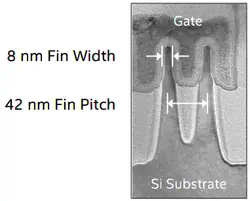(→14 nm Microprocessors) |
(→Industry) |
||
| Line 24: | Line 24: | ||
! colspan="2" | [[Intel]] !! colspan="2" | [[Samsung]] !! colspan="2" | [[GlobalFoundries]] !! colspan="2" | [[UMC]] !! colspan="2" | [[IBM]] | ! colspan="2" | [[Intel]] !! colspan="2" | [[Samsung]] !! colspan="2" | [[GlobalFoundries]] !! colspan="2" | [[UMC]] !! colspan="2" | [[IBM]] | ||
|- style="text-align: center;" | |- style="text-align: center;" | ||
| − | | colspan="2" | P1272 (CPU) / P1273 (SoC) || colspan="2" | 14LPE<info>1<sup>st</sup> generation; 14 nm Low Power Early</info>, 14LPP<info>2<sup>nd</sup> generation; 14 nm Low Power Performance</info>, 14LPC<info>3<sup>rd</sup> generation; 14 nm Low Power Cost [reduced]</info>, 14LPU<info>4<sup>th</sup> generation; 14 nm Low Power Ultimate</info> || colspan="2" | | + | | colspan="2" | P1272 (CPU) / P1273 (SoC) || colspan="2" | 14LPE<info>1<sup>st</sup> generation; 14 nm Low Power Early</info>, 14LPP<info>2<sup>nd</sup> generation; 14 nm Low Power Performance</info>, 14LPC<info>3<sup>rd</sup> generation; 14 nm Low Power Cost [reduced]</info>, 14LPU<info>4<sup>th</sup> generation; 14 nm Low Power Ultimate</info> || colspan="2" | 14LPP<info>2<sup>nd</sup> generation; 14 nm Low Power Performance</info> || colspan="2" | || colspan="2" | |
|- style="text-align: center;" | |- style="text-align: center;" | ||
| colspan="2" | 2014 || colspan="2" | 2015 || colspan="2" | 2015 || colspan="2" | 2017 || colspan="2" | 2015 | | colspan="2" | 2014 || colspan="2" | 2015 || colspan="2" | 2015 || colspan="2" | 2017 || colspan="2" | 2015 | ||
Revision as of 03:26, 29 January 2017
The 14 nanometer (14 nm) lithography process is a half-node semiconductor manufacturing process used as a stopgap between the 16 nm and 10 nm processes. The term "14 nm" is simply a commercial name for a generation of a certain size and its technology, as opposed to gate length or half pitch. Commercial integrated circuit manufacturing using 14 nm process began in 2014. This technology is set to be replaced with 10 nm process in 2017.
Contents
Industry
14 nm became Intel's 2nd generation finFET transistors. This process became Samsungs' and GlobalFoundries first generation of finFet-based transistors. Intel uses TiN pMOS / TiAlN nMOS while Samsung uses TiN pMOS / TiAIC nMOS as work function metals.
| Fab |
|---|
| Process Name |
| 1st Production |
| Type |
| Wafer |
| |
| Fin Pitch |
| Fin Width |
| Fin Height |
| Contacted Gate Pitch |
| Interconnect Pitch (M1P) |
| SRAM bit cell (HP) |
| SRAM bit cell (HD) |
| DRAM bit cell |
| Intel | Samsung | GlobalFoundries | UMC | IBM | |||||
|---|---|---|---|---|---|---|---|---|---|
| P1272 (CPU) / P1273 (SoC) | 14LPE 1st generation; 14 nm Low Power Early , 14LPP2nd generation; 14 nm Low Power Performance , 14LPC3rd generation; 14 nm Low Power Cost [reduced] , 14LPU4th generation; 14 nm Low Power Ultimate |
14LPP 2nd generation; 14 nm Low Power Performance |
|||||||
| 2014 | 2015 | 2015 | 2017 | 2015 | |||||
| Bulk FinFET | SOI FinFET | ||||||||
| 300mm | |||||||||
| Value | 22 nm Δ | Value | 20 nm Δ | Value | 20 nm Δ | Value | 28 nm Δ | Value | 22 nm Δ |
| 42 nm | 0.70x | 48 nm | N/A | 48 nm | N/A | ? nm | N/A | 42 nm | N/A |
| 8 nm | 1.00x | 8 nm | 8 nm | ? nm | 10 nm | ||||
| 42 nm | 1.24x | ~38 nm | ~38 nm | ? nm | 25 nm | ||||
| 70 nm | 0.78x | 78 nm | 1.22x | 78 nm | 1.22x | ? nm | ?x | 80 nm | 0.80x |
| 52 nm | 0.65x | 64 nm | 1.00x | 64 nm | 1.00x | ? nm | ?x | 64 nm | 0.80x |
| 0.0588 µm2 | 0.54x | 0.080 µm2 | ?x | 0.080 µm2 | ?x | ? µm2 | ?x | 0.900 µm2 | |
| 0.064 µm2 | ?x | 0.064 µm2 | ?x | ? µm2 | ?x | 0.081 µm2 | 0.81x | ||
| ? µm2 | ?x | 0.0174 µm2 | 0.67x | ||||||
Intel
| Intel 14nm Design Rules | ||
|---|---|---|
| Layer | Pitch | Scale Factor |
| Fin | 42 nm | 0.70 |
| Contacted Gate Pitch | 70 nm | 0.78 |
| Metal 0 | 56 | - |
| Metal 1 | 70 | 0.78 |
| Metal 2 | 52 | 0.65 |
Find models
Click to browse all 14 nm MPU models
14 nm Microprocessors
- Intel
- AMD
This list is incomplete; you can help by expanding it.
14 nm Microarchitectures
This list is incomplete; you can help by expanding it.
Documents
- A 14nm logic technology featuring 2 nd-generation FinFET, air-gapped interconnects, self-aligned double patterning and a 0.0588 µm 2 SRAM cell size, 15-17 Dec. 2014; 10.1109/IEDM.2014.7046976
 Semiconductor lithography processes technology
Semiconductor lithography processes technology
